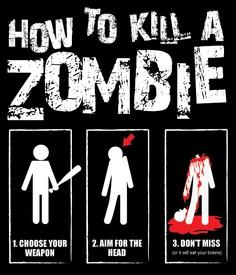
Killing Zombies is the act of rendering the moving corpse completely motionless once again. It can be argued that the term killing is technically inaccurate, as despite the observed locomotion of the zombie, all other life functions have ceased. Still, the point is mostly one of semantics. All you have to do is aim for the head, strike, and don't miss!
Destroying the brain
Nearly all zombie survivalists are in agreement that the destruction of the brain is the only surefire way to neutralize the zombie (though a few rare types of zombies require complete dismemberment). In World War Z and The Zombie Survival Guide, The Frontal Lobe is the area of the Zombie brain that still has limited function, and its destruction is key to putting a zombie down (in The Walking Dead, it is the brain stem. Still, in both works, substantial structural damage to any part of the brain is enough to stop the zombie). Some works of fiction (as well as self-proclaimed "zombie experts") would lead the public to believe that any tool that can break bones (from golf clubs, to chef's cleavers, to broomstick handles) will suffice. In reality, this is not the case and such notions are likely to get a person killed.
The skull is not only one of the thickest bones in the body, but the spherical shape of the cranium has evolved over countless eons of evolution to deflect and absorb tremendous amounts of force to preserve its precious cargo. Fracturing a skull to the point required to kill a zombie is no small feat without firearms. Although, decaying bones will soften and become more feeble. Capable Melee weapons are usually quite heavy, and draining to wield over time - perhaps even impossible to wield for smaller or weaker humans.
Without a weapon like a large axe, or sledgehammer, attacking the forehead, top, or back of the skull is not recommended. Baseball bats may fracture the skull, but typically not thoroughly enough in these areas to cause structural brain damage. The sides of the head, eyes, ears, and crux of the neck are better targets.
The temple on the right of the forehead and the area under the chin do not require as much exertion to overcome the skull's resistance, but the precision to hit these small targets under duress (and with attackers coming from multiple angles, as one-on-one zombie encounters are somewhat uncommon) usually makes these targets less than practical.
Most firearms are more than adequate for destroying an undead brain. However, smaller calibers may need to be much closer to do so on a reliable basis, and distance between the shooter and the undead horde is of the highest value. Most non-military firefights take place roughly 5-20 feet from its combatants. This is how many guns have been designed for decades, and it is not the same situation one desires when confronted with dozens of shambling corpses.
Mistakes
- Do not underestimate the effect fear may have on a survivor's capacity to fight, especially their first few encounters.
- It is usually better to avoid confrontation if possible, and instead flee undetected, especially if one isn't barricaded, or by a base. The groans of one zombie may bring many more than one can handle.
- As earlier mentioned, there is great misinformation in regards to the ease of fracturing the skull. Sometimes a sharp weapon to sever the spine at the neck is more practical.
- Some types of zombies are immune or ignorant of the sounds of gunfire. Some hone into it. Before letting off rounds indiscriminately, it's best to know which type is present.
- Do not underestimate how tiring it may be to penetrate a skull. It will rarely take only one swing, so be prepared. Be aware of your surroundings, and how much space you need to swing.
Things to consider before committing to battle
- If there is a melee weapon present, are you sure you know how to hold it?
- Are you sure it is durable enough to use without breaking in your hands?
- How long can you attack with it before exhaustion kicks in? If it does, what is plan B?
- Are you sure it can break the skull?
- Can you slip away unnoticed, or incapacitate/trap the zombie?
- How sure are you that their groans won't attract nearby zombies?
Infected/Fast Zombies
Many instances of Fast Zombies are not truly dead, merely humans in a rabid state, immune to pain, exhaustion, and mercy. While faster, and more hostile fighters than their slower cousins, they are ultimately more fragile. They can bleed out (major damage to the arteries of the neck, upper arms and legs can incapacitate them), and destroying the heart, lungs, spine or aorta can be instantly fatal. Still, because of their overwhelming ferocity, a glancing or mistimed blow with a melee weapon is usually the last mistake a human makes, so firearms are strongly advised.
